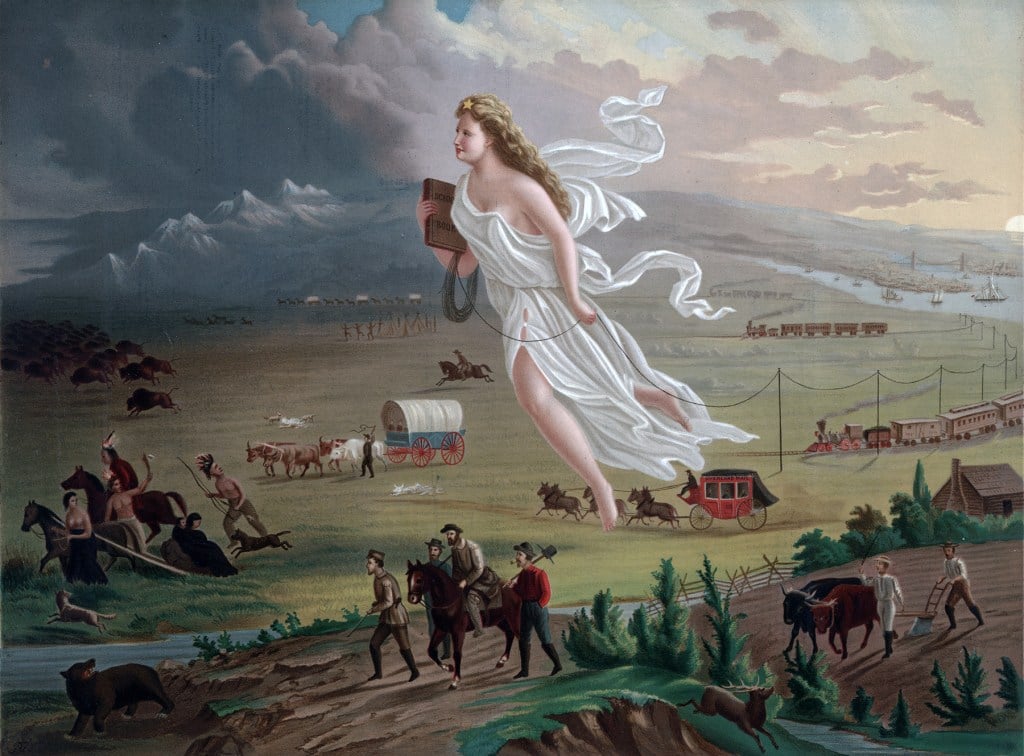LOS ANGELES—Last week, the official social media accounts of the Department of Homeland Security deviated from a series of action shots of Secretary Kristi Noem and various law enforcement officers to post a painting from the 19th century.
“American Progress” portrays a floating White woman leading the charge for homesteaders and technological progress, herding buffalo and Native people off western lands.
The painting, completed in 1872 by John Gast, is on display at the Autry Museum of the American West, nestled in the hills of Los Angeles. Over the weekend, it hosted festivities for the National Day of the Cowboy and Cowgirl, during which Stephen Aron, the museum’s director, invited The 19th to visit and discuss what this painting represents about America, empire and White womanhood.
The image of “American Progress” has been trending ever since it appeared across DHS’ social channels on July 23 with the caption: “A Heritage to be proud of, a Homeland worth Defending.” The painting is a deviation from the recent content on the official DHS Instagram page, which since Trump’s inauguration has become a collection of memes, vintage-inspired propaganda posters and highly-produced hype videos of law enforcement officers.
At the Autry, the small painting is part of an extensive salon tableau of wilderness canvases, depicting the American West as a fertile land to be conquered. People are secondary or absent in most works, with few exceptions. Next to “American Progress” is a large portrait of three White children and a dog, showing the type of life settlers were striving for in pursuit of manifest destiny.
In real-life Los Angeles, where the Autry is located, the city has been ground zero for the Trump administration’s federal immigration agenda, which has focused on a particular version of “Homeland’s Heritage” — one about protecting White women and families.
Founded in 1988 by Gene and Jackie Autry to share the heritage and legacy of the American West, the museum combines art, historical collections and cultural events. Central to its mission is bringing “together the stories of all peoples of the American West.”

This is exemplified by the layout of the gallery where “American Progress” lives. Aron points out three massive Navajo chief blankets are displayed across the room as a different kind of landscape. In the middle of the room is an enormous sculpture, known as “Grounded,” by third-generation Santa Clara Pueblo artist Rose B. Simpson.
“American Progress” was acquired after it was displayed as a part of a controversial 1991 exhibit at the Smithsonian Museum of Art that sought to reinterpret art of the American West with fresh context on conquest and colonization. Several lawmakers criticized the exhibit as overtly political, and threatened to defund the Washington, D.C. cultural institution in retaliation. Critics and patrons felt the exhibition unnecessarily villainized America’s history — a sharp contrast to the shining beam of progress depicted in Gast’s piece.
It’s a reaction that is echoing through American politics today, as the Trump administration considers removing books about slavery from national parks, erasing factual information that “disparages” American history and renaming a warship honoring LGBTQ+ activist Harvey Milk. Trump’s executive orders seek to rollback mentions of gender, racial and ethnic diversity from the federal government.
Experts at the Autry made clear that the capital-H “Heritage” celebrated in the DHS caption is a matryoshka doll of romanticization. The painting depicts three waves of “American Progress,” with a floating White woman bearing “the star of empire” ushering Indigenous people and animals out of the frame, leading the way for miners and homesteaders. It’s looking back on the 1840s through the eyes of post-Civil War America, when the West represented a way to stitch together the nation and provide a rebirth, Aron told me.
In order for White Americans to settle in the West, they had to unsettle a diverse group of Indigenous, Spanish and Mexican people. And the main symbol — and weapon — of settlement was the White family, said Virginia Scharff, distinguished professor emerita at the University of New Mexico and chair of Western history at the Autry.
“The presence of White women is absolutely essential to the idea of permanent occupation of formerly Indigenous lands by the United States and the cementing of a legitimacy to occupy that land,” Scharff said. White men first headed west alone, to work on railroads or as miners, but they didn’t begin to occupy the land in a meaningful way on their own.
And in Gast’s painting, White womanhood looms large — literally. Clad in classical white, the passive figure brings light westward; in contrast to the bare-breasted Indigenous woman, she embodies decency and civility.
As this spectre of “progress” claimed new states in the mid-1800s, the rights of women diverged based on racial and ethnic background. “There were always women who existed there prior to Americans coming, who had different ideas of womanhood, different roles in their communities, that often became under attack when a new government was established,” said Carolyn Brocken, senior curator at the Autry, during a phone call.
Mexican women had more rights than American women in the East, including the ability to own property, Brocken said. Native women, who participated in public councils across myriad tribal traditions, were removed from ancestral lands and different cultural ideals were forced upon them.
At the same time, Gast’s floating, symbolic woman erases the very real contributions of women on the frontier. “You miss how much women were active agents of change in the West,” Brocken said. They fought for their rights and communities — Wyoming was the first state to legalize women’s suffrage in 1869. In contrast to the resurgence of traditional gender roles today, gender roles could be more fluid in frontier communities with limited resources, and women slowly gained more independence through expanded work and responsibilities.
Scharff sees the strategic deployment of the “American Progress” painting as deeply insidious. “The Department of Homeland Security is not sending scantily clad White women,” she said, “but instead sending guys with guns and truncheons and masks to grab people off the streets.”
“There’s a deliberate kind of deception being practiced here that is really cynical and really dangerous, in my view.”
DHS Assistant Secretary Tricia McLaughlin told The 19th in a statement that the agency ”honors artwork that celebrates America’s heritage and history.” She added: “If the media needs a history lesson on the brave men and women who blazed the trails and forged this Republic from the sweat of their brow, we are happy to send them a history textbook.”
But at the Autry, context is everything. “We’re doing everything we can, both in the physical space and also when we’re doing interpretive work, to try to contextualize this kind of art in American history,” Scharff said.
She considers Simpson’s “Witness,” which is usually displayed alongside “American Progress,” to be the most powerful piece in the entire collection. “It speaks to the people who are made invisible, muted and chased off the edge of the canvas by this type of art, but they’re still there,” she said. “Their presence is undeniable if you just look.”
When Simpson’s work was displayed in an eighteenth-century home, the artist commented on being “out of place.”
“There have been times when I wanted to speak only to people who could understand my work,” Simpson said in an interview. “Yet if my sculptures are out of place, they’re actually working harder than if they’re surrounded by my context. I want my sculptures to go into difficult places; they’re intended to infiltrate.”
“Witness” has been temporarily replaced by its accompanying sculpture “Grounded,” a clay figure crouched on the ground with black wings reaching to the ceiling. “Witness” was relocated to the floor below as a part of a temporary exhibit called “Future Imaginaries: Indigenous Art, Fashion, Technology.”
Upstairs, Aron explains, the art is meant to remind patrons of the time before the beginning mythologized by painters like Gast. “Future Imaginaries” is meant to show Indigenous history is not just in the past, but also that there is a present and a future.
In its temporary surroundings, “Witness” towers over Aron. He addressed its usual placement while standing in front of the post-apocalyptic clay figure. “Bearing witness to the paintings of manifest destiny stands, I think, if not as a rebuke, then at least as a reminder of whose homeland, whose heritage, who’s first and who’s still here,” he said.
Great Job Jasmine Mithani & the Team @ The 19th Source link for sharing this story.





